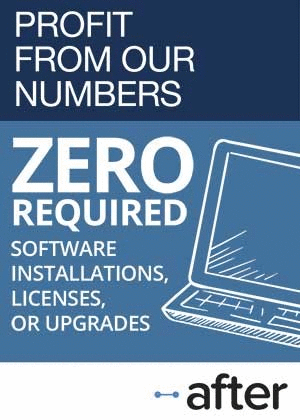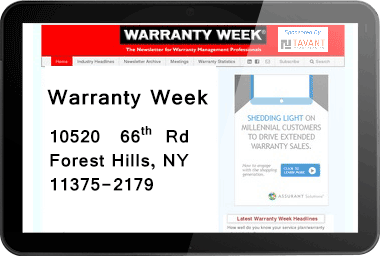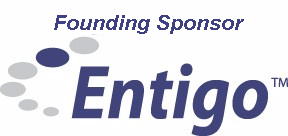Top 100 Warranty Providers of 2009:
By comparing companies to themselves over time, we're able to identify those with the biggest changes in claims and accrual rates. And while change is good, too much change may not be. Appearances on multiple top 10 lists can imply instability or an unfamiliarity with the warranty process.
As the calendar flips over to April, it's time to give one last look back at the calendar year 2009, and the financial results of the top 100 warranty providers.
This time around, we had to stretch the list a bit and use warranty data from the top 111 companies, because 11 of them have yet to (or never will) file their financial reports for the end of calendar 2009 with the U.S. Securities and Exchange Commission. Year-end reports are past-due from Champion Enterprises Inc.; Delphi Corp.; Fleetwood Enterprises Inc.; Nortek Inc.; Nortel Networks Corp.; and Sun Microsystems Inc. Year-end reports were filed by Building Materials Corp. of America; Exide Technologies; Fortune Brands Inc.; and Goodyear Tire & Rubber Co., but they did not include the required warranty data.
Several of these companies are in the middle of bankruptcy reorganizations. Several have been recently acquired or are in the process of winding up their operations. But none provided the needed warranty data, so we found 11 other companies to evaluate instead.
Methodology
The top 100 warranty providers were selected based on their reported totals for claims paid in 2009. They were then evaluated based on their year-ending claims rates, accrual rates, and warranty reserves. Those figures were compared to the corresponding year-end 2008 figures.
The idea is to compare each company to itself over time, and then to compare the magnitude of the changes to each other. That way, we're not making any comparisons of claims or accrual rates, which are different for each industry and every product line. Instead, we're comparing the increases or decreases, and looking for the most unusual.
The top 10 increases and decreases can then be listed in the tables that follow. Companies that appear on two or even three lists are the most volatile. With claims and accrual rates, decreases are usually good while increases are usually bad. For warranty reserves, the opposite is usually true. We say "usually" because sometimes the changes are caused by acquisitions, divestitures, or internal accounting changes, rather than changes in product quality or repair costs.
In 2009, the big story was of course the global recession that caused sales to plummet and unemployment to soar. By our calculations, warranted product sales fell by 20% in the U.S. last year. Meanwhile, the total amount of warranty accruals reported by all warranty providers fell by 22.3% to $21.1 billion, while the amount of claims paid fell by 12.2% to $25.2 billion.
Because sales and accruals fell faster than claims, and because the claims rate and accrual rate are calculated by dividing sales into claims and accrual figures, the percentages rose for most companies last year. Still, there were companies that reduced those percentages last year. There were even some that saw warranted product sales increase.
Top 10 Accrual Reductions
In Figure 1 below, we listed the top 10 accrual rate reductions among the top 100 warranty providers. These are the companies that for one reason or another decided to cut the amounts they set aside when a product is sold, to finance future warranty work. For instance, Nvidia set aside 21% of its product revenue in the third quarter, but set aside 0% in the fourth quarter. At the end of 2008, meanwhile, it set aside 0.7%. So its warranty accrual rate reduction for 2008 to 2009 was 100%.
Figure 1
Top 100 U.S.-based Warranty Providers:
Top Ten Accrual Rate Reductions,
Calendar Year 2009 vs. 2008
(accruals in $ millions and % of sales)
| Accruals | Accruals | Accruals | Accruals | Rate Now | |
| Made | Rate | Made | Rate | vs. | |
| Company | 2008 | Dec 08 | 2009 | Dec 09 | Year Ago |
| Nvidia Corp. | $227 | 0.7% | $219 | 0.0% | -100% |
| NACCO Industries Inc. | $79 | 2.2% | $26 | 1.2% | -45% |
| Novellus Systems Inc. | $74 | 7.4% | $26 | 4.1% | -45% |
| Harman International | $130 | 2.2% | $40 | 1.3% | -43% |
| Palm Inc. | $97 | 7.5% | $16 | 4.4% | -41% |
| EMC Corp. | $161 | 2.5% | $146 | 1.6% | -35% |
| Bruker Corp. | $32 | 3.3% | $21 | 2.1% | -35% |
| Rockwell Collins Inc. | $63 | 1.1% | $42 | 0.8% | -34% |
| Mohawk Industries | $92 | 2.5% | $52 | 1.8% | -28% |
| Seagate Technology | $267 | 2.7% | $246 | 2.0% | -25% |
Source: Warranty Week from SEC data
Nvidia has been plagued by graphics board defects, so the 21% accrual rate seen in the third quarter of 2009 (or the 23% rate seen in the third quarter of 2008) are not surprising. What is surprising is that Nvidia followed each of these freak quarters with by equally freakish quarters in which absolutely no accruals were made. In other words, the company is probably reacting to its over-accruals with under-accruals. It would be much better if it simply made accurate accruals (or better products).
Nvidia, then, is an example of an accrual rate reduction not being good. For most of the others in Figure 1, however, the rate reduction is a good thing. For instance, Novellus brought its accrual rate down from 7.4% to 4.1%, despite a 29% reduction in sales. Palm brought its accrual rate down from 7.5% to 4.4%, despite an 81% reduction in sales.
Confirming or Contradicting the Trend
Novellus also saw its claims rate fall by a large percentage, so it's also listed in Figure 3 below. Palm, however, saw its claims rate rise by a large percentage, so it's also listed in Figure 4. In other words, for Novellus, the wisdom of the big accrual rate reduction was confirmed by a big claims rate reduction. But for Palm, the accrual reduction was contradicted by the claims rise.
In Figure 2, the five companies at the top of the list saw fit to increase their accrual rates by 100% or more. We phrase it this way because accruals and accrual rates are something a company can determine for itself, adjusting them up or down depending on what they forecast in terms of claims. Some say a company could artificially reduce its accruals in order to boost profitability, but auditors would step in to prevent this from happening.
In Figure 2, these are companies that chose to increase their accruals the most, which reduces profitability. So it's not something a company would do on a whim. Still, it's hard to imagine why a company such as Goodman Global would need to increase its accrual rate ten-fold, or why Steelcase would need to increase its accruals nearly five-fold. That is, unless one were to peek ahead and see in Figure 4 that they also each had massive claims increases.
Figure 2
Top 100 U.S.-based Warranty Providers:
Top Ten Accrual Rate Increases,
Calendar Year 2009 vs. 2008
(accruals in $ millions and % of sales)
| Accruals | Accruals | Accruals | Accruals | Rate Now | |
| Made | Rate | Made | Rate | vs. | |
| Company | 2008 | Dec 08 | 2009 | Dec 09 | Year Ago |
| Goodman Global Inc. | $46 | 0.3% | $59 | 3.2% | +987% |
| Steelcase Inc. | $9.3 | 0.3% | $36 | 1.5% | +379% |
| Bucyrus International | $13 | 0.3% | $33 | 1.2% | +359% |
| TRW Automotive | $38 | 0.3% | $63 | 0.5% | +114% |
| Xerox Corp. | $39 | 1.3% | $34 | 2.6% | +104% |
| Medtronic Inc. | $18 | 0.2% | $50 | 0.3% | +95% |
| Tyco International Ltd. | $24 | 0.2% | $39 | 0.4% | +82% |
| Hovnanian Enterprises | $63 | 2.0% | $54 | 3.6% | +79% |
| Brunswick Corp. | $95 | 2.6% | $89 | 4.6% | +75% |
| Pulte Homes Inc. | $30 | 0.5% | $34 | 0.9% | +73% |
Source: Warranty Week from SEC data
A total of 37 companies on the top 100 list reduced their accrual rates in the final quarter of 2009 (compared to the final quarter of 2008), while 62 companies increased their accrual rates. One company kept its accrual rate exactly the same.
At the other end of the spectrum, 27 of the companies on the top 100 list saw their claims rates fall in 2009, while 73 saw this rate rise. The reason for most of these rises is simple: sales fell faster than claims. This is normal during recessions. In 2009, companies were fixing products sold in 2007 or 2008, when times were better. So while sales fell 29% on average, claims fell only 14%.
Reducing Warranty Claims
In Figure 3, we've listed the top 10 claims rate reductions of 2009. The three companies at the top of the list saw their claims rates fall by half or more. Six more saw the rate fall by a third or more. Incredibly, all but EMC and Seagate also saw their product sales fall.
Figure 3
Top 100 U.S.-based Warranty Providers:
Top Ten Claims Rate Reductions,
Calendar Year 2009 vs. 2008
(claims in $ millions and % of sales)
| Claims | Claims | Claims | Claims | Rate Now | |
| Paid | Rate | Paid | Rate | vs. | |
| Company | 2008 | Dec 08 | 2009 | Dec 09 | Year Ago |
| Microsoft Corp. | $568 | 4.5% | $353 | 1.4% | -70% |
| KLA-Tencor Corp. | $49 | 3.6% | $24 | 1.5% | -59% |
| Oshkosh Corp. | $68 | 1.1% | $53 | 0.5% | -53% |
| Novellus Systems Inc. | $94 | 9.3% | $30 | 4.7% | -49% |
| Emerson Electric Co. | $203 | 1.3% | $186 | 0.9% | -35% |
| Bruker Corp. | $35 | 3.6% | $23 | 2.3% | -34% |
| Tyco International | $73 | 0.5% | $55 | 0.4% | -34% |
| EMC Corp. | $155 | 2.5% | $143 | 1.6% | -34% |
| D.R. Horton Inc. | $38 | 0.8% | $23 | 0.5% | -34% |
| Seagate Technology | $251 | 2.5% | $232 | 1.7% | -32% |
Source: Warranty Week from SEC data
Meanwhile, at the other extreme, all ten of the companies listed in Figure 4 saw their claims rates rise by 100% or more. Goodman Global and SanDisk saw increases of more than 1,000%. And while Goodman also increased its accruals by large amounts, SanDisk increased accruals by only a modest 5.4%. Nvidia made no accruals in the fourth quarter, and Mohawk reduced its accruals by 28%. AMD and Palm reduced their accruals more modestly.
Caused by Sales Reductions?
As mentioned, most of these claims rate increases had more to do with sales reductions than anything related to product quality or repair costs. However, it's a bit strange that several of these were accompanied by accrual rate reductions. If it had nothing to do with warranty costs and everything to do with sales reductions, one would have expected accrual rates to remain unchanged while claims rates rose sharply.
Figure 4
Top 100 U.S.-based Warranty Providers:
Top Ten Claims Rate Increases,
Calendar Year 2009 vs. 2008
(claims in $ millions and % of sales)
| Claims | Claims | Claims | Claims | Rate Now | |
| Paid | Rate | Paid | Rate | vs. | |
| Company | 2008 | Dec 08 | 2009 | Dec 09 | Year Ago |
| Goodman Global Inc. | $48 | 0.004% | $59 | 3.2% | +88833% |
| SanDisk Corp. | $3.0 | 0.1% | $34 | 1.1% | +1444% |
| Nvidia Corp. | $50 | 1.4% | $186 | 7.0% | +419% |
| Steelcase Inc. | $10 | 0.4% | $37 | 1.5% | +282% |
| Eastman Kodak Co. | $108 | 1.3% | $92 | 3.4% | +162% |
| Mohawk Industries | $82 | 2.2% | $167 | 5.8% | +160% |
| Xerox Corp. | $38 | 1.2% | $41 | 3.1% | +153% |
| Wabco Holdings Inc. | $26 | 1.0% | $36 | 2.4% | +142% |
| Advanced Micro Devices | $26 | 0.3% | $30 | 0.6% | +115% |
| Palm Inc. | $82 | 6.0% | $42 | 12% | +105% |
Source: Warranty Week from SEC data
One can also look at the warranty reserve balance to determine which of the top warranty providers are managing their accounts prudently and which are making it up as they go along. The companies in Figures 5 and 6 are ranked based upon the percentage increase or decrease seen in their warranty reserve balance from the end of 2008 to the end of 2009.
Unlike claims and accrual rates, for which reductions would seem to be preferable to increases, with warranty reserves one would seem to prefer larger balances to smaller. So we've listed the top 10 increases first, in Figure 5.
Rising Reserves
Only Apple saw its warranty reserve balance rise by 100% or more. In fact, only 36 of the top 100 companies saw their warranty reserve balance rise at all. Most allowed their warranty reserves to shrink instead, which one would expect if sales also fell and therefore the need for funds to repair products in the future also fell.
But Apple was also one of only 17 companies on the top 100 list to also see product sales rise. In other words, more products were sold, so more accruals were made, and the warranty reserve balance rose. Others listed in Figure 5 that also saw sales increases include Johnson Controls, Western Digital, and Joy Global.
Figure 5
Top 100 U.S.-based Warranty Providers:
Top Ten Warranty Reserve Increases,
Calendar Year 2009 vs. 2008
(balance change in $ millions and percent)
| Warranty | Warranty | $ Change | % Change | |
| Reserve | Reserve | vs. Year | vs. Year | |
| Company | Dec 08 | Dec 09 | Before | Before |
| Apple Inc. | $265 | $584 | +$319 | +120% |
| Johnson Controls | $191 | $333 | +$142 | +74% |
| Pulte Homes Inc. | $58 | $96 | +$38 | +65% |
| Diebold Inc. | $43 | $63 | +$20 | +46% |
| Western Digital | $121 | $155 | +$34 | +28% |
| Joy Global Inc. | $47 | $59 | +$12 | +26% |
| Sherwin Williams | $18 | $22 | +$4 | +23% |
| Lennar Corp. | $129 | $158 | +$28 | +22% |
| Mohawk Industries | $56 | $67 | +$10 | +18% |
| ITT Corp. | $57 | $67 | +$10 | +17% |
Source: Warranty Week from SEC data
Conversely, the only company listed in Figure 6 that also saw product sales increase was SanDisk. And as was already mentioned, SanDisk not only reduced warranty reserves but did so in spite of a massive rise in warranty claims. This is a dangerous combination, and is one that Palm and Xerox also followed. If we were either investors or customers of these companies, we'd be very worried.
Figure 6
Top 100 U.S.-based Warranty Providers:
Top Ten Warranty Reserve Decreases,
Calendar Year 2009 vs. 2008
(balance change in $ millions and percent)
| Warranty | Warranty | $ Change | % Change | |
| Reserve | Reserve | vs. Year | vs. Year | |
| Company | Dec 08 | Dec 09 | Before | Before |
| Palm Inc. | $51 | $14 | -$37 | -73% |
| KLA-Tencor Corp. | $27 | $16 | -$11 | -42% |
| Microsoft Corp. | $490 | $308 | -$182 | -37% |
| NACCO Industries | $60 | $39 | -$21 | -36% |
| Novellus Systems | $30 | $20 | -$11 | -36% |
| SanDisk Corp. | $36 | $26 | -$11 | -29% |
| Thor Industries | $59 | $43 | -$16 | -28% |
| Xerox Corp. | $27 | $20 | -$7 | -26% |
| D.R. Horton Inc. | $73 | $54 | -$19 | -26% |
| BorgWarner Inc. | $82 | $62 | -$20 | -25% |
Source: Warranty Week from SEC data
Others that appeared on multiple lists include KLA-Tencor Corp.; NACCO Industries Inc.; Mohawk Industries Inc.; Novellus Systems Inc.; and Pulte Homes Inc. Nine others appeared on two lists, and 22 companies appeared on just one list. And that means 61 of the top 100 appeared on none of these top 10 lists.
Most Volatile Warranty Providers
For many of these companies, their appearance on one or more lists can be easily explained by a massive change in sales totals, or by a big change in their product lines, perhaps related to an acquisition or a divestiture. However, the fact that only 39 of the top 100 warranty providers appeared on any list proves that these are also the most volatile of the top 100 warranty providers.
We're not saying that a high claims rate is a bad thing, or that a company with a 3% claims rate is somehow better than one with a 4% or a 5% claims rate. We're not comparing companies to each other at all. Instead, we're comparing companies to themselves over time, and we're spotlighting the companies that changed the most over the past year.
Totals & Averages: Claims are down. But accruals are down by more, and it looks like they're down by more than they should be. Ten charts provide a snapshot of the warranty landscape as manufacturers enter the recovery phase.April 8, 2010








